This is a guest blog by the Cal Poly Rockfish lab about the California Collaborative Fisheries Research Program (CCFRP) and the status of rockfish on the Central Coast.
West Coast groundfishes, particularly rockfishes (Sebastes spp.), comprise an important commercial and recreational fishery in California and have historically made up a large proportion of nearshore recreational catch in Central California. The rockfish complex along our coast is composed of 45 managed species that have a wide range of life histories, preferred habitat and prey, and depth ranges. Unlike most fish species, rockfishes give birth to live young! Depending on the species, these pelagic larvae typically spend anywhere from one to three months floating around in the ocean before settling out as juveniles on their preferred habitats, which can include shallow rocky outcroppings or kelp forests.
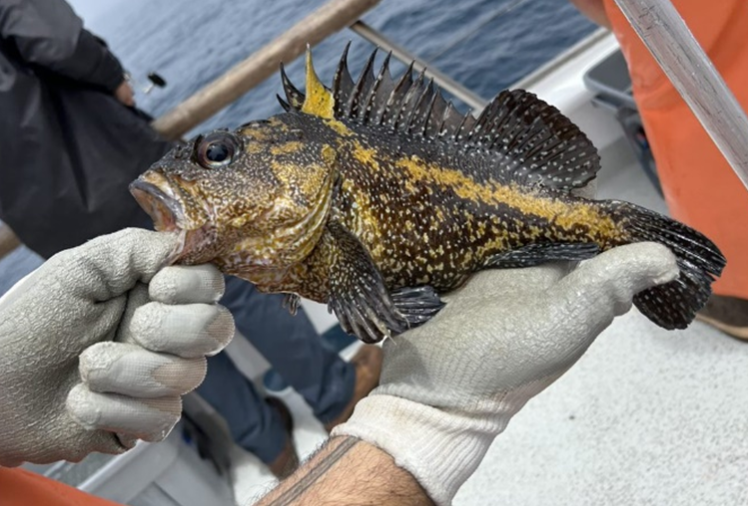
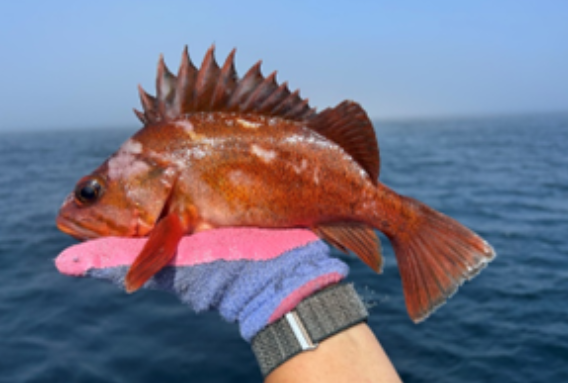
Rockfish species are generally long-lived, slow-growing fishes that live anywhere from 40 to over 100 years, making proper management important for maintaining population levels. In the past, declines in rockfish populations and other nearshore species led to more restrictive spatial management practices, including the implementation of a network of Marine Protected Areas (MPAs) along the coast of California. These MPAs were designed to contribute to the ecological goals of the Marine Life Protection Act, which focuses on rebuilding marine life populations.
Collaborative Fisheries Research Program
The California Collaborative Fisheries Research Program (CCFRP) began on the Central Coast in 2007 and was expanded statewide in 2017, with a total of six participating institutions. Dr. Dean Wendt from Cal Poly, San Luis Obispo and Dr. Richard Starr from Moss Landing Marine Laboratories created CCFRP in collaboration with boat captains, the fishing community, academic and agency scientists, and non-governmental organizations. CCFRP relies heavily on the active collaboration of these groups to complete this research. This program was designed with the dual goals of monitoring MPAs in California using hook-and-line catch-and-release fishing surveys and engaging stakeholders in data collection and education.
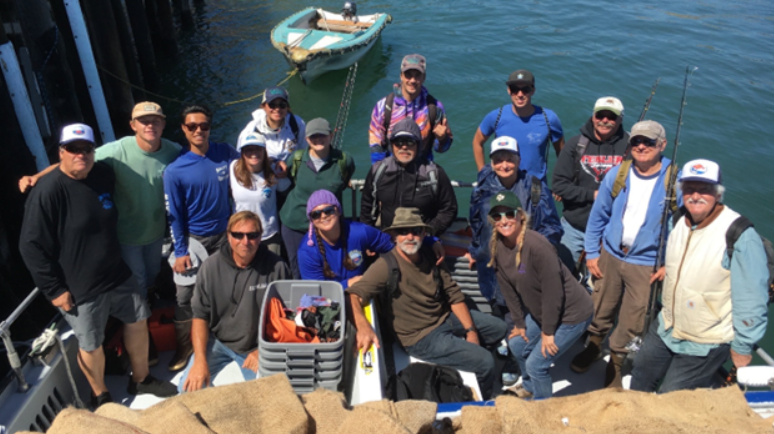
Here in San Luis Obispo, CCFRP samples come from two local MPAs, Point Buchon and Piedras Blancas State Marine Reserves (a type of MPA in which no take is allowed), and their associated reference sites (areas nearby that are open to fishing). Each sampling day involves taking a group of scientists and volunteer anglers to fish in either the MPA or reference site. Any fish caught by a volunteer angler during a standardized amount of fishing time is identified, measured, tagged if it is in good condition, and released by the science crew.
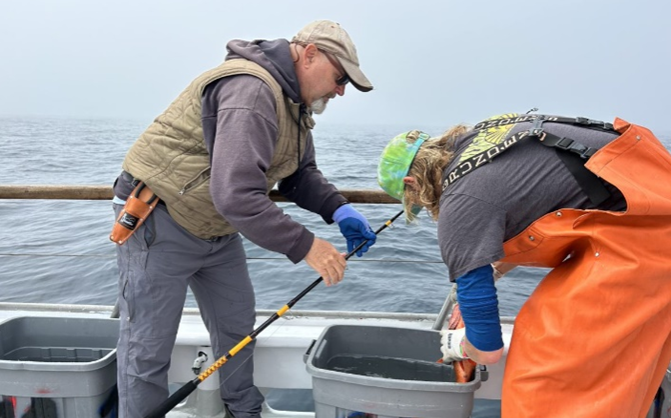
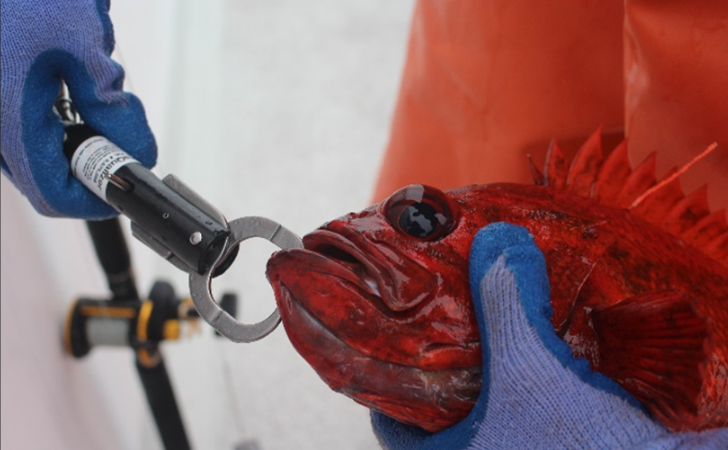
From 2007 to 2022 the Cal Poly chapter of CCFRP has caught and released 66,149 fishes and tagged 23,727 of them. Of these fish, 43,084 were caught inside either the Point Buchon or Piedras Blancas MPA. Visit our public database to see more of the data collected by CCFRP.
If you are interested in volunteering to fish with CCFRP, you can visit our website and sign up to volunteer with one of the six CCFRP institutions.
MPAs Are Effective Spatial Management Tools
After 17 years of research, our results generally point in one direction: fish caught inside MPAs tend to be larger and more abundant than those in areas open to fishing. These results become more significant with larger and older MPAs.
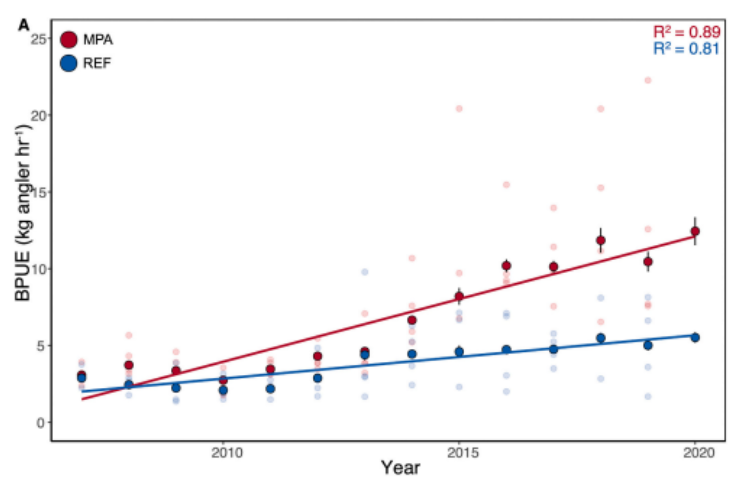
MPAs are also more resilient with respect to the diversity of species within them, and species diversity tends to recover faster from large climatic perturbations when compared to reference sites. After the large marine heatwave that took place from 2014 to 2016, diversity recovered up to 75% faster inside MPAs compared to adjacent reference sites in subsequent years.
Groundfishes in the Morro Bay Estuary
While CCFRP does not sample the MPAs within Morro Bay Estuary, the estuary itself comprises two types of MPA: a State Marine Reserve (SMR) where no take is allowed, and a State Marine Recreational Management Area (SMRMA) where recreational take of finfish is only allowed North of latitude 35° 19.700’ N. Estuary habitats are extremely dynamic, with both freshwater and saltwater inputs. Even so, many fish species use estuaries as important juvenile habitat because they are more protected relative to other coastal ecosystems. Many nearshore groundfish species such as Olive Rockfish (Sebastes serranoides), Grass Rockfish (Sebastes rastrelliger), Gopher Rockfish (Sebastes carnatus), and Lingcod (Ophiodon elongatus) have been spotted in Morro Bay and may be utilizing the estuary for habitat and hunting grounds regularly.
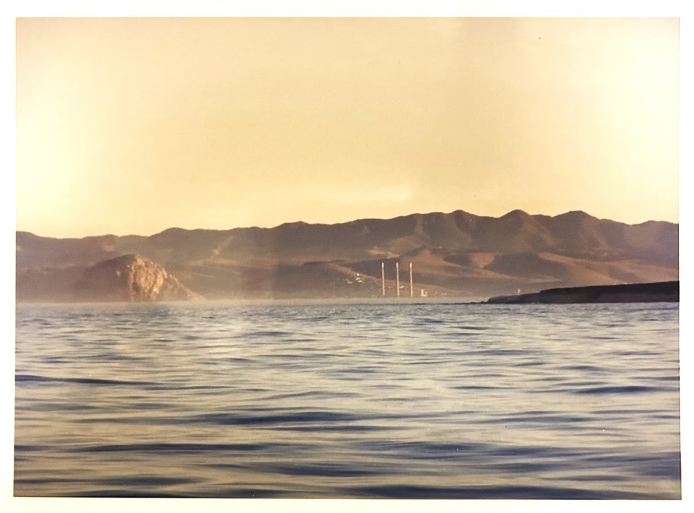
References
Gleason, M., Fox, E., Ashcraft, S., Vasques, J., Whiteman, E., Serpa, P., Saarman, E., Caldwell, M., Frimodig, A., Miller-Henson, M., Kirlin, J., Ota, B., Pope, E., Weber, M., & Wiseman, K. “Designing a network of marine protected areas in California: Achievements, costs, lessons learned, and challenges ahead”. Ocean and Coastal Management, 74, 90–101 (2013).
Love, M. S., P. Morris, M. McCrae, and R. Collins. “Life history aspects of 19 rockfish species (Scorpaenidae: Sebastes) from the Southern California Bight”. NOAA Tech. Rep. NMFS 87, 38 p (1990).
Love, M. S., Yoklavich, M., & Thorsteinson, L. K. (2002). The Rockfishes of the Northeast Pacific. University of California Press.
Starr, R.M., D.E. Wendt, C.L. Barnes, C.I. Marks, D. Malone, G. Waltz, K.T. Schmidt, J. Chiu, A.L. Launer, N.C Hall, and N. Yochum. “Variation in responses of fishes across multiple reserves within a network of marine protected areas in temperate waters”. PLoS One, 10(3), e0118502 (2015). https://doi.org/10.1371/journal.pone.0118502
Stephens, J., Wendt, D., Wilson-Vandenberg, D., Carroll, J., Nakamura, R., Nakada, E., Rienecke, S., & Wilson, J. “Rockfish resources of the South Central California Coast: analysis of the resource from partyboat data, 1980-2005”. In CalCOFI Rep Vol. 47 (2006).
Ziegler, S.L., R.O. Brooks, S.L. Hamilton, B.I. Ruttenberg, J.A. Chiu, R.T. Fields, G.T. Waltz, C. Shen, D.E. Wendt and R.M. Starr. (2022). External fishing effort regulates the positive effects of no-take marine protected areas. Biological Conservation 269, 109546
Ziegler, S.L., J.M. Johnson, R.O. Brooks, E.M. Johnston, J.L. Mohay, B.I. Ruttenberg, R.M. Starr, G.T. Waltz, D.E. Wendt and S.L. Hamilton. “Marine protected areas, marine heatwaves, and the resilience of nearshore fish communities”. Scientific Reports 12:1405 (2023).
Ziegler, S.L., R.O. Brooks, L.F. Bellquist, J.E. Caselle, S.G. Morgan, T.J. Mulligan, B.I. Ruttenberg, B.X. Semmens, R.M. Starr, J. Tyburczy, D.E. Wendt, A. Buchheister, J.R. Marin Jarrin, C. Pasparakis, S.J. Jorgensen, J.A. Chiu, J. Colby, C.L. Coscino, L. Davis, F. de Castro, J.T. Elstner, C. Honeyman, E.T. Jarvis Mason, E.M. Johnston, S.L. Small, J. Staton, G.T. Waltz, B. Basnett, E.V. Satterthwaite, H. Killeen, C.D. Dibble, S.L. Hamilton. “Collaborative fisheries research reveals reserve size and age determine efficacy across a network of marine protected areas”. Conservation Letters e13000 (2024). https://doi.org/10.1111/conl.13000
Help us protect and restore the Morro Bay estuary!
- Donate to the Estuary Program today and support our work in the field, the lab, and beyond.
The Estuary Program is a 501(c)3 nonprofit. We depend on funding from grants and generous donors to continue our work. - Support us by purchasing estuary-themed gear from ESTERO. This locally owned and operated company donates 20% of proceeds from its Estuary clothing line and 100% of Estuary decal proceeds to the Estuary Program. Thank you, ESTERO!
- Purchase items from the Estuary Program’s store on Zazzle. Zazzle prints and ships your items, and the Estuary Program receives 10% of the proceeds.
- Subscribe to our seasonal newsletter: Between the Tides!
- We want to hear from you! Please take a few minutes to fill out this short survey about what type of events you’d like to see from the Estuary Program. We appreciate your input!